
by EMILY SPICER
Nnenna Okore’s diaphanous sculptures appear to grow out of sterile gallery walls, like unfurling flowers that seem both of the world we live in now and an earlier, primordial version. But Okore’s works are not simply representations of the planet’s flora. Although it is possible to pick out fading petals, wilting stamen and tangled masses of roots, these structures are better described as uncanny abstracts that encapsulate more than the sum of their parts.
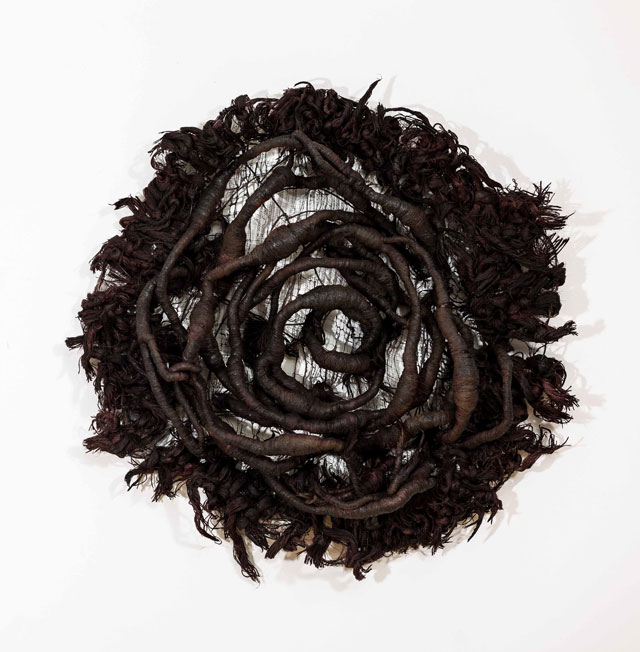
Nnenna Okore. Deeply Rooted, 2017. Cheesecloth, jute strings, dye and wire, 92 x 92 x 23 cm. Photograph: Jonathan Greet. Courtesy October Gallery, London.
In Okore’s hands, the static becomes animated and vital. She uses a combination of biodegradable materials, such as hessian, paper and ceramic, and weaves them into fluid, poetic forms that speak of decay and renewal. The natural world lies at the heart of everything she creates. “My inspirations derive from varying organic forms in nature,” she tells me, and she is “especially captivated by the ephemeral passage of time”.
Okore performs a kind of artistic alchemy, a complex transformation of the recycled substance into something new and valuable that, in turn, represents its earthy origins. These transformations encapsulate the rhythms of the natural world and it is the disruption of these rhythms that troubles Okore deeply.
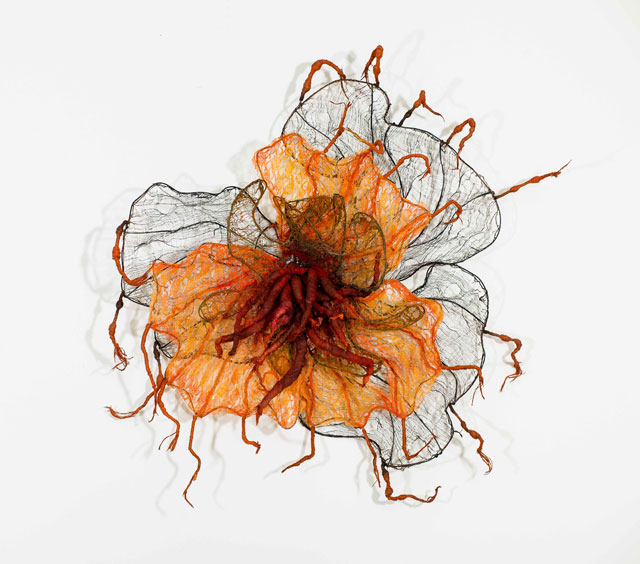
Nnenna Okore. Ethereal Beauty, 2017. Cheesecloth, jute string, lace, dye and wire, 99 x 107 x 31 cm. Photograph: Jonathan Greet. Courtesy October Gallery, London.
The artist, who was born in Australia in 1975 was raised mainly in Nigeria, and now lives and works there and in Chicago. She talks to Studio International about her work.
Emily Spicer: Tell me a little about the importance of the human in your work and humanity’s relationship with the environment.
Nnenna Okore: Man has a symbiotic relationship with the Earth. We depend on the natural surroundings for sustenance, shelter and survival. Ecological and climatic conditions in the natural habitat reflect how well we manage Earth’s resources. We can only ensure our longevity if we protect and preserve the planet. Climate change is increasingly becoming a dire crisis for humanity. Ironically, this is being triggered by indiscriminate human activities. My work seeks to highlight Earth’s vulnerability and fragility. By disrupting the flow of natural activities, we stand to loose in the long run.
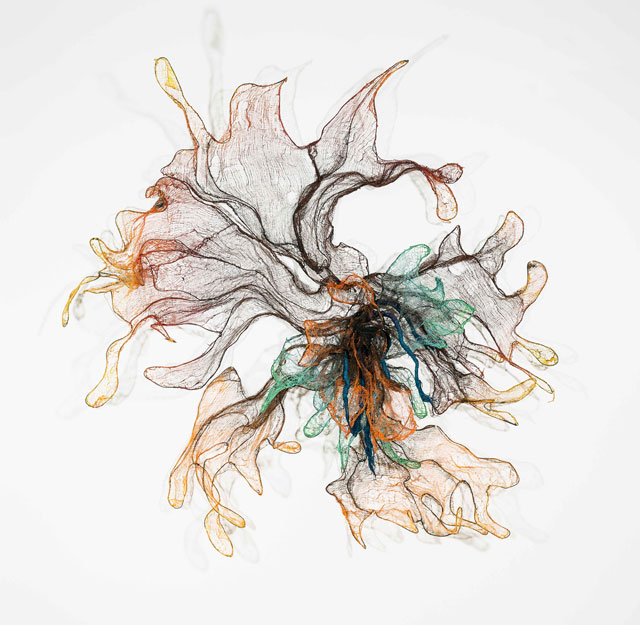
Nnenna Okore. Here and Now. 2017. Cheesecloth, jute string, dye and wire, 209 x 203 x 33 cm. Photograph: Jonathan Greet. Courtesy October Gallery, London.
ES: Some of your works look like flowers on the verge of dying, and some of your titles allude to the passing of time. And while these titles are beautiful and the works rich in colour, there seems to be a sense of melancholy in them, too. Is your work born from a longing for something that is lost?
NO: I am interested in expressing the beauty of life and death. Flora, the symbol that I use repeatedly in my work, represents the journey of life. In its lifespan, the flower experiences a flourishing climax followed by a series of deflation. It embodies the fleeting nature of existence. I therefore strive to celebrate the beauty of life while it lasts. Even after it fades away, another bloom will come in the form of a new birth, [and] tomorrow, the sunlight. I am astounded by nature’s ability to regenerate. Death will always give way to birth, as the cosmic laws have ordained.
ES: To me, your sculptures are like visual poems, woven into intricate structures from unlikely materials. And the titles read like excerpts from a novel: Never Hurry the Sunrise, Would We Ever know?, Everything Good Shall Come to Pass. Is literature an influence in your work?
NO: Indeed, it is. Works of great African writers such as Chinua Achebe and Cyprian Ekwensi profoundly inspire me. As you rightly observe, I theme my works metaphorically and poetically. In so doing, I layer the title with nuance and depth.
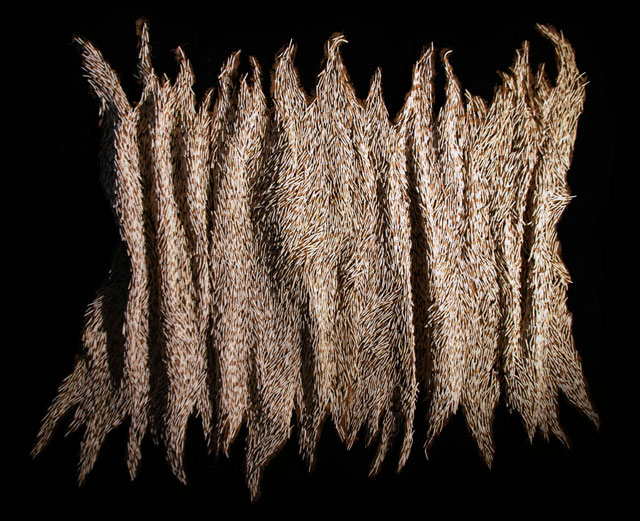
Nnenna Okore. Hide, 2014. Ceramic and burlap, 216 x 280 x 31 cm. Courtesy October Gallery London.
ES: The botanical forms you construct are larger than life and almost otherworldly. Would you say that there is an element of theatre in your work? Has the theatre inspired you?
NO: Certainly, the theatrics of space is an important aspect of my sculptural displays and installation. I am intrigued by the juxtaposition of delicate movements and the play of light. With every turn, entanglement or accumulation, the spatial elements appear to breathe, dance and cascade through space. Also the drama of light and shadow is deliberately infused into the piece to further the sensorial experience.
ES: How important is colour to you, and how do you choose your colours?
NO: I am a fan of colour, especially loud earthy tones such as red, orange, ochre and yellow. Colour gives character to my work. Although, I must say that my reasons for using specific colours are highly subjective. Sometimes, it’s based on my sentiments and emotion, or the theme of the work. Other times, I defer to the colours of the materials themselves and have no say.
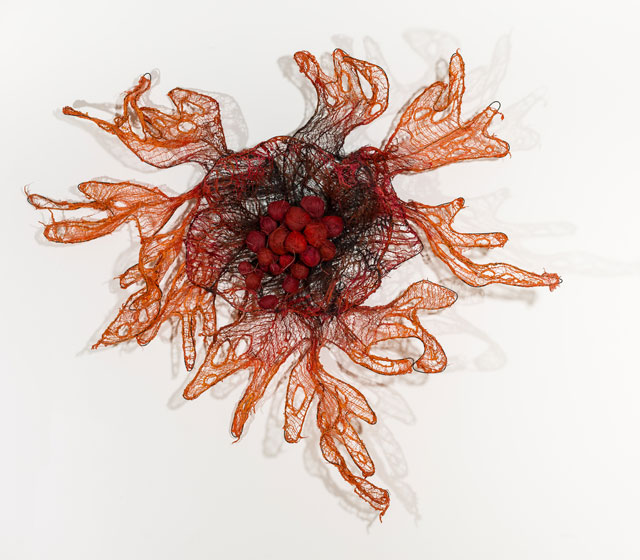
Nnenna Okore. Ihe Di Ife, 2017. Cheesecloth, burlap. jute strings. dye and wire, 127 x 173 x 23 cm. Photograph: Jonathan Greet. Courtesy October Gallery, London.
ES: You initially studied painting at the University of Nigeria, and then decided to study for an MA in sculpture. What caused this shift?
NO: While I thoroughly enjoyed playing with colour on two-dimensional surfaces, I was more drawn to tactility, to physical structure and accumulations. The switch to sculpture brought great satisfaction, as I was able to incorporate vibrant spatial elements in three-dimensional space. I think, more than anything, it was the desire to engage space and the viewers that propelled me to switch to a sculptural mode. My works continue to embrace colours and painterly elements nonetheless.
ES: You moved from Nigeria to the US to study for your MA. Why did you travel to America and did this move have an impact on your work?
NO: I did. It was always my long-term ambition to grow my theoretical knowledge of art and develop an informed studio practice in a research-based environment. Once my first degree was completed, I worked hard for a couple of years to create a portfolio and to research for graduate school. My graduate experience was definitely a turning point in my career, as it helped me define my aesthetic interests and ethos, while steering me in the direction that I have continued to pursue.
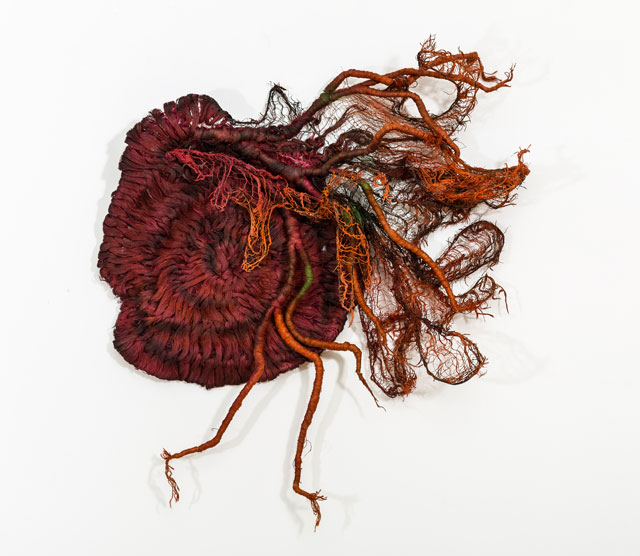
Nnenna Okore. On the Long Run, 2017. Cheesecloth, burlap, jute strings, dye and wire, 127 x 117 x 38 cm. Photograph: Jonathan Greet. Courtesy October Gallery, London.
ES: Are the techniques involved in creating your works rooted in craft traditions or in personal experimentation?
NO: A little bit of both, I think. There are elements of my work that rely heavily on the knowledge and use of traditional craft-based processes, such as weaving, sewing or dyeing. But then, many of techniques are instinctive or arbitrary in approach. Generally speaking, there are no hard and fast rules in my art-making technique. I employ and adopt any process that allows me to accentuate the familiar or unfamiliar characteristics of my materials, while loosing myself to the dynamic possibilities.
ES: How did you make Hide (2014) and what was the inspiration behind the hundreds of pieces of ceramic?
NO: My sole aim of working with clay is to transform and disguise its materiality to a point where it has little resemblance to its original state or function. I wanted to evoke more questions than answers by creating an unusual surface that undulates through an assemblage of accumulated textures. Slowly and steadily, I rolled each piece of clay between my palms until I had the critical mass to weave into the large strips of hessian. I called it “Hide” because it reminded me of skin or tree bark, peeled from its original body – akin to leather or eucalyptus bark.
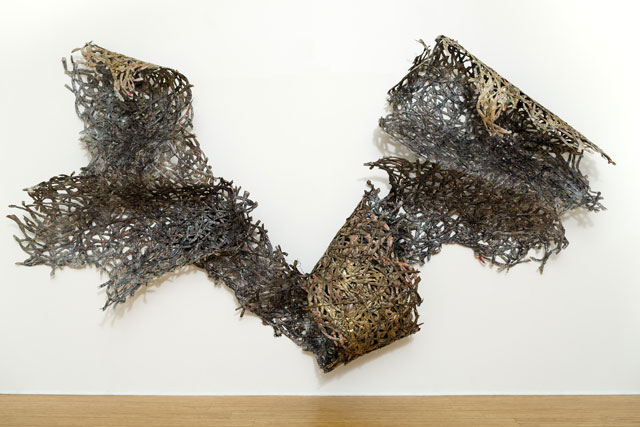
Nnenna Okore. Unleashed, 2017. Newspaper, acrylic paint and wire, 266 x 457 x 69 cm. Photograph: Jonathan Greet. Courtesy October Gallery, London.
ES: It must have taken you a long time!
NO: It took more than six months to produce the piece.
ES: Your work was exhibited at Art X Lagos last year, which received attention as West Africa’s first international art fair, and there seems to be a huge number of Nigerian artists bursting on to the world stage. What do you think has precipitated this increased recognition of Nigerian talent?
NO: A number of factors seem to be playing simultaneously in this trend. First, Africans are beginning to take ownership of their destiny by relying less on foreign entities to chart their paths on the world stage. Second, the increased curatorial presence in landmark art events across the globe means that Africans can give a voice to shining stars from the continent. Then, to a large extent, credit should be given to the art auction houses and international African fairs, such as Art X and AKAA [Also Known As Africa] for projecting and promoting works by African artists. To answer the last bit of your question, Nigerians have always been known to be fiercely prolific in intellectual and creative capacities. The international platforms have created vast opportunities for Nigerians to become more visible and appreciated.
ES: What are you working towards at the moment?
NO: There are a few projects in the pipeline. As one of four artists recently selected by Threewalls Gallery to participate in a research project in Chicago, I am working on a collaborative environmental project in the city. I am also preparing for a few regional and international exhibitions.
With thanks to October Gallery in London.